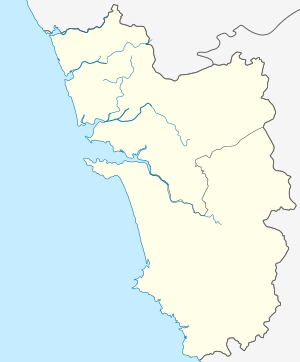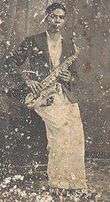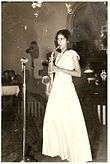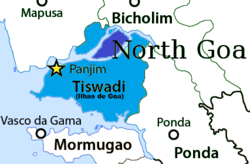Divar
| Divar Divaddi | |
|---|---|
| Island | |
|
Location of Divar (dark blue) in Ilhas ae Goa (light blue) | |
 Divar  Divar | |
| Coordinates: 15°31′31.6″N 73°53′59.9″E / 15.525444°N 73.899972°ECoordinates: 15°31′31.6″N 73°53′59.9″E / 15.525444°N 73.899972°E | |
| Country |
|
| State | Goa |
| District | North Goa |
| Taluka | Ilhas |
| Named for | Dipavati or 'small Island' |
| Government | |
| • Type |
2 Panchayats, 3 Communidades |
| Elevation | 8 m (26 ft) |
| Population | |
| • Total | approx. 2,250 |
| Time zone | IST (UTC+5:30) |
| Postcode | 403403 |
| Telephone code | 0832 |
The island of Divar (Konkani: Divaddi, pronounced [d̪iːwaːɽiː]) (derived from the word Dipavati or 'small Island' in Konkani) lies in the Mandovi river in the Indian state of Goa.
Location
It is located approximately upriver 10 km (6 mi) from Panjim. The Island is connected to Old Goa on the south-east side, Ribandar, on the south-west side and Narve on the north side, all by ferry. A launch also connects Divar to the city of Panjim from further north-west, in the island-village of Vanxim. The Konkan Railway passes through the village and the nearest stop to the village is the train station at Carambolim.
The drive to the village is scenic, with paddy fields and wooded hills lacing the roadway, very typical of the Goan countryside.
Villages
Initially, there were three Communidades in Divar : Piedade, São Matias (now Malar), Goathias. The Piedade Communidade was later sub-divided into two, Goltim and Navelim.
According to legend, the original inhabitants of this island were people who once lived in Old Goa but had to desert during a disastrous pestilence that heavily decimated the population of Old Goa.
Piedade (Goltim-Navelim)
Spread at the bottom of a small forested hillock, Piedade, is a small typical Goan village. The Church of Our Lady of Compassion sits on top of this hillock overlooking the horizon. From the top of the hill, superb panoramic views of the surrounding countryside, including the meandering Mandovi river and Old Goa can be seen. Well maintained, elegant Portuguese villas can be seen dotting the island. The famous Bonderam festival is celebrated in Divar, on the fourth Saturday of August during the monsoon with great fanfare and attended by thousands of tourists and locals. In recent years, the inflow of non-Goans has changed the demographics, skyline and landscape of the village(s).
Malar
Another typical Goan village, São Matias (now Malar) lies close to the island-village of Vanxim; which also part of the Malar Panchayat. The Konkan Railway passes through Malar, the nearest stop on the mainland is the train station at Carambolim. Ferry Connection from Narva to Narva-Bicholim, also Ferry Connection from the Island to Old Goa, and Ribander. The São Mathias Church was built by the Portuguese over 400 years ago. The St Mathias Sports Club is situated on the main road of the village. The locals here tend to have their own identity from the rest of the island. They celebrate Bonderam in the more traditional way with absolutely no floats.
Naroa
Naroa, located on the eastern tip of the island, has a population of barely a thousand people, with about 80 houses dotting the tiny village. This place was a site of a tirth place and also of a Hindu temple that remained up to the time of Portuguese conquest. The place because of sanctity attracted many devotees from all over. It was annually visited by devotees who came here to bathe and veneration. The Island subsequently became the residence place of many dignified families of Goa. It also houses three parochial churches and possesses a chapel of two images of Christ held in great veneration by the Catholics of the place. The ruins of a fort are evident in the northern part of the village.
Naroa Fort
Fort Naroa, located on the Island of Divar opposite the old city of Goa in Ilhas, was originally built by the Muslims. It was abandoned in 1834 and is now in ruins.It provides one of the best places for sightseeing in Goa.
Porne Tirth
Porne Tirth , Place of shri. Saptakoteshwar temple and Koti Tirth Lake (still exist on the island) has 108 carved small temples which is government-occupied place (archaeological site).
History
The original inhabitants of this island were people who once lived in Old Goa but had to leave during a disastrous plague that greatly reduced the population of Old Goa. They are mainly of Luso Indian and Konkani descent.
Ever since the Capture of Goa by India, there has been a sharp increase in the number of immigrant Hindus from neighbouring states, on the island (some of them even claiming to be its original inhabitants). This has led to a permanent change in the demographics, culture and landscape (as seen in all of Goa). This has also led to destruction of the mangroves, water quality and forest life in the region to make room for the new arrivals.
It is believed that the Island of Divar was once a site of Hindu pilgrimage - one of many in India - and hosted the temples of Shree Saptakoteshwar, Shree Ganesh and Shree Dwarkeshwar. During the Christianization of Goa, in the 16th century, many were shifted, by the Portuguese, to other locations, as they fell out of favor by the locals of the region.
It's said, that the current Cemetery near Church at hilltop once housed Ganesh Temple. The Hindus were asked to take the Ganesh Idol and rehabilitated it in village of Khandola near Marcel (still in Portuguese Goa). The ancient site of pilgrimage is called Porne Tirth (Old pilgrim spot-in Konkani).
Rui Gomes Pereira in his biased book Goan Temples and Deities writes, " The original temple of Shree Saptakoteshwar was constructed in the 12th century by the kings of Kadamba Dynasty. Shree Saptakoteshwar was the patron deity of the Kadambas. The temple was destroyed by the Sultan of the Deccan in the middle of the 14th century. It was reconstructed at the same locality by Madhav Mantri of Vijaynagara at the close of the same century. It was again destroyed by the Portuguese in 1540." Prior to its destruction, the temple used to attract up to three thousand pilgrims from Goa itself during its annual procession. The Saptakoteshwar idol and temple was relocated to Narve in Bicholim by the Portuguese. The present temple structure in Narve, Bicholim was funded and rebuilt by Shivaji a Maratha leader.
A Jesuit priest Fr. Francisco Sousa documented the religious importance of Divar in his book Oriente Conquistado (Conquest of the orient) around the latter quarter of the 16th or early 17th century. According to him, "Divar was as much venerated by the Hindu Brahmins as the Holy land by us, on account of a temple of many indulgences and pilgrimages..."
According to Dr Olivinho J F Gomes, Professor of Konkani, Divar was one of the first places the Portuguese ventured to convert locals to Christianity, targeting primarily the Hindu Brahmin caste, thus creating the Roman Catholic Brahmin community.
Festivities
Bonderam
Similar to the Carnival, the famous Bonderam festival is celebrated in Divar on the fourth Saturday of August during the monsoon with great fanfare and attended by thousands of tourists and locals. Bonderam Festival: The festival is a memoir to the dispute and the fury of the Villagers over the Portuguese system of resolving the disputes. The villagers on the Divar Island often indulged in some kind of fight over the matter of ownership of their lands. To stop the disputes the Portuguese, put up flags at the boundaries. The villagers did not like this system. So they protested against the Portuguese by throwing stones at the flags. On this day a carnival ambiance is created. Each section of the village has a float at the parade. Melodious music could be heard throughout the village. The gaily coloured floats accompanied by colorfully dressed youngsters make a pretty picture.
Potekar
Similar to, Halloween, the Potekar festival is celebrated for three days before the start of Lent/ Ash Wednesday, where local youths wear homemade masks, costumes, cow bells; venturing around the village, receiving/demanding snacks & drinks from locals, and have licence to frighten the village children!
Feast of Our Lord Redeemer
The feast of the Miraculous Image of Our Lord Redeemer (Konkani: Jezu Soddvonnarachi Ojeapanchi Imaj) is celebrated every year at Piedade, Divar' in the month of November on a Sunday closest to 18 November. The traditional feast is celebrated by one of the village families and draws devotees from all over Goa. The image is said to have been brought by late Ferrão of Goltim, from Europe and was kept in his house which has today become the chapel.
Churches
Church of Our Lady of Compassion, Piedade
The Church of Our Lady of Compassion is located in the village of Piedade; which though small, is one of the island's largest villages, that has great panoramic views. The church which was designed by a Goan priest is known to be the first Christian structure erected here and is a charismatic building dating from the early 1700s.
The Our Lady of Compassion church atop a hill is situated at the site of an ancient Hindu temple which is believed to have been destroyed in the late 15th century by the Muslims. Masonry of this temple seen by Albuquerque from his ship in 1515 when he returned to Goa for the last time was incorporated into the church.
To the south side of the church of Our Lady of Compassion one can see a remnant of the illustrious Kadamba era. One will also come across a chapel enclosed in a tiny walled cemetery which is believed to have been converted from a former Hindu shrine. The Ganesh temple which earlier housed the deity was relocated by the Portuguese to its present site at Candola.
The fragment of ornate stone tracery that can be seen in the window is known to have been carved in about the same time as the foundation of the Shiva (Mahadev) temple of Tambdi Surla. Also the carving and painted plaster decoration on the ceiling is thought to be original.
Church bell
The huge bell which today adorns the Se Cathedral in Old Goa was originally donated by the master of a sinking ship who'd made a vow that, were he to survive his fate, he would donate the ship's bell to the first church village, town, or city his vessel touched. It so happened that that island was Divar. In keeping with his promise, he donated the bell to the church of Divar, which is located on a high hillock. Unfortunately though, every time the bell was struck, it shattered the windows of the church and the houses in the vicinity, so a deal was struck and the bell was exchanged with that of the Se Cathedral.
São Matias, Malar
This church is 410 years old and is dedicated to St. Mathias. The village derives its name from the church.
Our Lady of Candelaria, Naroa
The devotion to Our Lady of Candelaria is characteristic of fishermen and became relatively common in the Iberian Peninsula only in the 18th century. The Chapel of Our Lady of Candelaria or Purification on Divar Island is a round building covered by a hemispherical vault with skylight cupola. The exterior wall is articulated by pilasters topped above the cornice balustrade by ball pinnacles. A long nave in the form of a stone shed was recently added hidding the east-facing door giving access to the rotunda. Another shed-like construction hides the small sanctuary to the west. It is probable that the dedication to Our Lady of Candelaria dates to 1763, when the chapel was subject to major interventions on the initiative of Viceroy Manuel de Saldanha, Count of Ega (1758-1765). The windows and round oculi with scroll pediments we see ornamenting the rotunda’s perimeter may be ascribed to the tastes of that period. The original chapel was founded in 1543, perhaps dedicated to Our Lady of Pity; the devotion was later transferred to the main church of Divar. A century later, in 1633, the chapel must have been redone in the form we see today. The date is inscribed at the base of an image of Our Lady. Almost all the architectural moulding, especially the shafts and pinnacles, seems to be early 17th century. The rotunda’s entrance nevertheless seems to be from the middle of the previous century, dating perhaps to when the original chapel was founded. Two narrow shafted pilasters with plant motifs support a sharp triangular pediment above an overly weak frieze. Although this was just an isolated chapel, the building dedicated to Our Lady of Candelaria is significant in the context of architecture in the former Estado da Índia, where churches and chapels with central plans are rare, except in Goa’s Islands district. The Naroa chapel stands out from all other chapels or chapel vestiges with central plans on the Islands due to its size and formal perfection.
Temples
As a result of the recent mass immigration, Divar Island has a large number of temples, many of which are relatively new. The most prominent of them is the Shri Ganesh Sateri Temple at Sateri Bhat. There are three Temples of Ganesh; one at Navelim, one at Hilltop near the Church and third is at Maddar wado. And several built throughout the island.
Cuisine
Urak
Divar is one of few places in Goa you will find Urak (mild version of Cashew Feni) all-year round. For a small island, Divar has a variety of bars, serving Urak & local food (esp. seafood). Good quality Urak available at Damien Bar, frequented mainly by Farmers and Fishermen.
Restaurants
Mayur Bar produces their own Urak (and serve good Prawns). Alternatively there is the Julio Bar, Rock Inn, Seaview, Bradley's and Rajaram small Taverna in the Malar area, to name a few. Suresh, Step-Inn & 4 Numbers Bar for late night drinks.
Notable people
Clergy
- Fr. Jacome Gonsalves, Catholic missionary to Sri Lanka, "Father of Sinhala Catholic literature"
- Fr. José Antonio Gonçalves of Divar: He was one of the initiators of the Conspiracy of the Pintos; and planned a rebellion against Portuguese Rule, in 1787. He was Professor of Philosophy at the (former Jesuit) College of Maddel, Chorão.
- Dom Matheus de Castro (c. 1594−1679) the first Indian Bishop of The Catholic Church,[1] was a native of Divar. He was consecrated Bishop of Chrysopolis by the Vatican and sent to India during the Viceroyalty of Conde de Aveiras (1635–1640), as Vicar Apostolic for the Kingdoms of Bijapur, Golconda, Abyssinia and Pegu.
- His Nephew Dom Thomas de Castro (c. 1621-1689) was consecrated Bishop of Fulsivelem by the Vatican in 1671. He was appointed Vicar Apostolic for the Kingdoms of Cochin, Tamor, Madurai, Mysore, Cranganore, Cannanore and the Coast of Canara.
Both Uncle and Nephew were at constant loggerheads with the Padroado. They were vehemently opposed to the Goa Inquisition, Throughout using their effort and influence to rid Goa of the same.[2]
Musicians



Jose Mathias Pacheco was bandleader of Madras Gymkanna Club. Migrated to Ceylon in the 40’s and worked as piano tuner in Colombo. Back again to Madras,started music business of hiring pianos & other instruments ( tuning & repairing ), played double bass for Madras Philharmonic Orchestra and various bands. Retired to Goa in 70’s (d. Feb 19, 1976). He had owned more than 100 pianos during that time
Lucila Pacheco, in the mid-’60s caused a sensation in the Mumbai studios by becoming the first player of an electronic instrument . In the 1940s, Lucilla Pacheco was one of the few women on the Bombay jazz scene, playing in the all-star band of Mickey Correa at the Taj Mahal Hotel and with the Anglo-Indian band leader Ken Mac. She later joined the Hindi film industry, and performed regularly with the arranger Anthony Gonsalves. But she isn’t remembered merely for being a woman in a man’s world. In the 1960s.
Anibal Castro, the legendary trombonist, who is also fluent with multiple instruments i.e. guitar, saxophone,flute, etc. has been performing for the last 50 years and more. His first musical breaks in Mumbai were in the early years recording at the Bollywood studios with Shankar and Jaikaishen. He has performed with many musicians playing classical, blues, jazz and big band music in India, Europe and USA. He played with Mohammed Rafi's entourage in the USA. Some of the great Indian Classical musicians like Pandit Shivkumar Sharma, Pandit Chourasia, Pandit Trilok Gurtu learnt lessons of the western harmony from this great Musician of Divar. He was also part of some fusions concerts with Ustad Allarkha and Bhavani Shankar. He is descendent from the same family as Dom. Matheus de Castro the first Indian Bishop of the Catholic Church.
See also
References
- ↑ Biographical dictionary of christian missions by Gerald H. Anderson, Wm. B. Eerdmans, 1999 Pg 121
- ↑ Gerald H. Anderson (1999). Biographical dictionary of Christian missions. Wm. B. Eerdmans Publishing. p. 121. ISBN 0-8028-4680-7.
- Goa Vol I - Hindu Temples & Deities by Rui Gomes Pereira. A. Gomes Pereira 1978.Gomes Pereira Rd, Panaji, Goa. SC: 240 pp.
- Indian Prelates - a biographical sketch of 7 Goan Bishops by Jno. Godinho, Bombay, 1924
